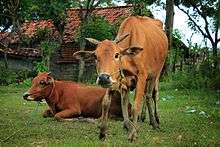Madura cattle

Madura cattle are a stable, inbred hybrid of Zebu and Banteng (Bos javanicus).[1][2] They originated on the island of Madura near northeastern Java, where the original cattle population was Banteng, very similar to Bali cattle. Sinhala cattle, a Zebu breed from Sri Lanka, were introduced more than 1500 years ago, and the cross was found to be better than either of the original breeds. Some sources say the Zebu component was Ongole Cattle from India.[3] The colouration is reddish brown with non-specific white patterning on the back and rump. They are a small breed, bulls having a mature weight of 250 to 300 kg,[4] used for racing[5] and are sometimes called dancing cattle. In 2002 the population was estimated by the FAO at 900,000. Efforts are being made to conserve the breed on Sapudi island[6]
Madura bull racing
In bull racing two bulls are yoked together, pulling a small sled on which the driver attempts to balance over a hundred-metre course.
References
- ↑ Heredity (2003-09-24). "Paternally inherited markers in bovine hybrid populations". Nature.com. Retrieved 2013-07-11.
- ↑ Popescu, C.P; Smith, W.G (1988). "A Cytogenetic Investigation of Madura Cattle". Reproduction in Domestic Animals. Blackwell-synergy.com. 23 (3): 145. doi:10.1111/j.1439-0531.1988.tb01092.x. Retrieved 2013-07-11.
- ↑ "Food and Agriculture Organisation of the United Nations report p4" (PDF). Retrieved 2013-07-11.
- ↑ Rural Indonesia: Socio-economic Development in a Changing Environment By Erik Thorbecke, Theodore van der Pluijm. Books.google.co.uk. 1993. ISBN 9780814781975. Retrieved 2013-07-11.
- ↑ "Bull racing on Madura". Indonesialogue.com. 2007-04-11. Retrieved 2013-07-11.
- ↑ "Food and Agriculture Organisation of the United Nations report p25" (PDF). Retrieved 2013-07-11.